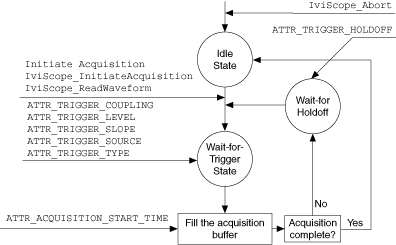IviScope Behavior Model
The following state diagram shows relationships between the IviScope Base capability group and oscilloscope behavior.

IviScope Behavior Model
 |
Note The following extension groups follow the IviScope behavior model: IviScopeTVTrigger, IviScopeRuntTrigger, IviScopeGlitchTrigger, IviScopeWidthTrigger, IviScopeWaveformMeasurement, IviScopeProbeAutoSense, IviScopeSampleMode, IviScopeAcLineTrigger, IviScopeInterpolation, IviScopeAverageAcquisition, IviScopeTriggerModifier, IviScopeAutoSetup, and IviScopeMinMaxWaveform. |
Typically, you configure the oscilloscope while it is in the Idle state. You can configure the oscilloscope by accessing the IviScope attributes individually or by calling the high-level Configure Channel, Configure Acquisition Record, Configure Trigger, and Configure Edge Trigger Source functions.
To acquire waveforms, the IviScope class driver presents the high-level Read Waveform function, as well as the low-level functions Initiate Acquisition, Acquisition Complete, Fetch Waveform, and Abort.
The Read Waveform function initiates a waveform acquisition and returns the acquired waveform after the oscilloscope has returned to the Idle state.
The Initiate Acquisition, Fetch Waveform, and Abort functions give you low-level control over the measurement process. Initiate Acquisition initiates a waveform acquisition and moves the instrument into the Wait-For-Trigger state. You configure the type of trigger with the trigger subsystem attributes or with the Configure Trigger and Configure Edge Trigger Source functions.
Once the trigger event occurs, the oscilloscope acquires a waveform based on the channel and acquisition subsystem attributes. If the oscilloscope was able to fill all of the points in the waveform in real-time it then returns to the Idle state. However, if the oscilloscope must acquire multiple waveforms in equivalent-time sampling to build up the waveform record, it then moves to the Wait-For-Holdoff state. The oscilloscope then waits configurable amount of time before moving to the Wait-For-Trigger state.
After enough waveforms have been acquired to fill the waveform record, the oscilloscope returns to the Idle state. You can use the Acquisition Status function to determine if the acquisition is complete or is still in progress.
You can use the Fetch Waveform function to return a waveform from a previously initiated acquisition. The Read Waveform and Fetch Waveform functions return the following parameters:
- a waveform array
- the time of the first point in the waveform array relative to the trigger event
- the effective time interval between points in the array